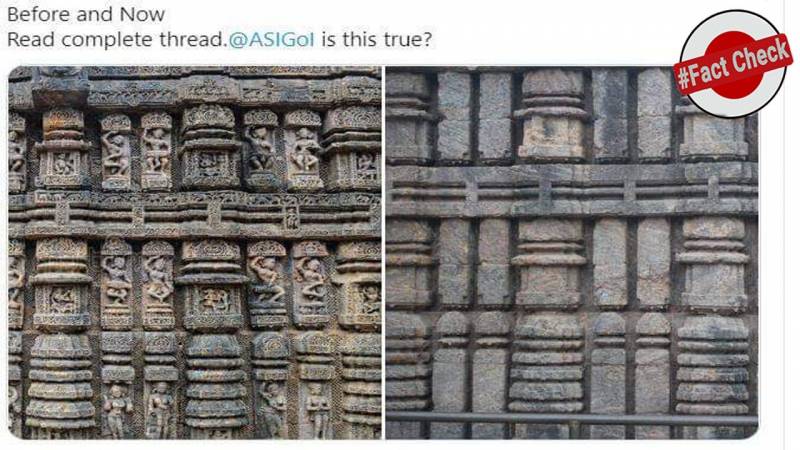Fact Check: Is ASI replacing Konark Temple's sculptures with plain stones?
By Satya Priya BN
Hyderabad: Built in the 13th century CE the Konark Sun temple is an architectural marvel. Located about 36 km northeast of Puri, Odisha, it has been declared a UNESCO heritage site. However, the temple now lays in ruins. The idol of the Sun god was lost or stolen, and sculptures in the temple were destroyed by time, nature, and humans.
What remains now is the temple complex, a 100 ft chariot of the Sun god on twelve pairs of elaborately decorated wheels, and drawn by seven horses. The Archeological Survey of India (ASI) has been trying to restore the temple for many years.
A Twitter user earlier tweeted a collage of two images claiming these were images of the temple walls that are being disfigured in the name of restoration by the ASI. This image was first posted in March 2019 saying, "Visit this architectural marvel before all its sculptures are replaced with plain sandstones #Konark".
These tweets are being circulated in the social media, raising mistrust about the ASI restoration work.
Intervention in architectural conservation should be the minimum necessary,practically involves some loss a 'value' in the heritage structure, but justified in order to preserve the building for future use. There are 7 degrees of interventions in the architectural conservation. https://t.co/OIz3sLirwu
— swaroop ray (@Lydat79) April 3, 2019
Fact Check:
According to the news media reports, Archaeological Survey of India gave clarification that no engraving has been replaced with plain stones in Sun temple at Konark, Odisha's only World Heritage Site, after tweets on monument went viral
The Archeological Survey of India has clarified that this tweet is FALSE. It explained, "The 2 images shown in the tweet are from different locations. The image with sculptures is from Natya Mandapa while the plain stones images are from the plinth of Jagmohana (the main temple)."
ASI also tweeted another image of the north-east side of the platform which was in a very bad condition and said there was no evidence of the type of sculptures present there. So, it was restored using plain stones in 1985. "The plain stonework shown in the image was done in the mid-1980s. ASI used plain stone only wherein there was no evidence left & as per ASI's the-then archaeological policy, only such portions were filled with plain stones. ASI would like to confirm that no sculpture has been replaced," it tweeted.
Therefore, the claim that ASI has been replacing sculptures with plain stones is FALSE. The plain stonework shown in the image was done in 1985, where there was NO evidence of sculptures left on the monument.